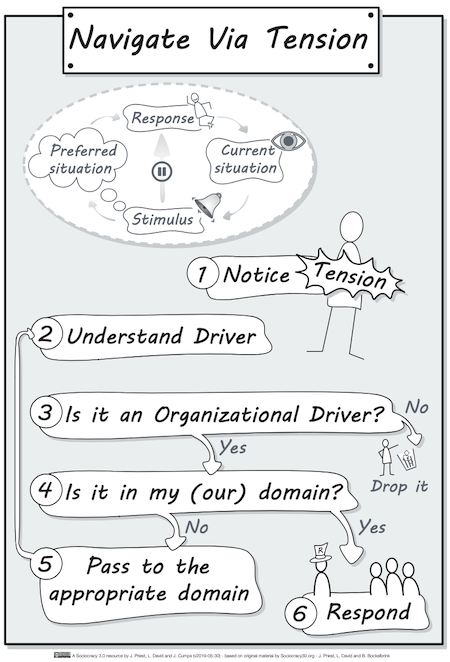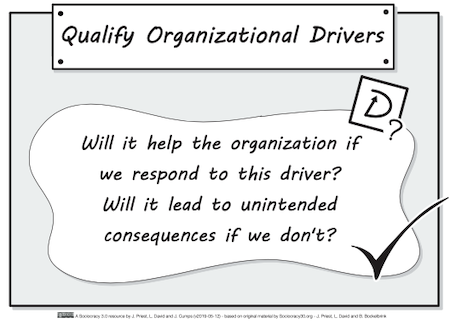Understand and Assign Drivers
People in an organization are the sensors (and actors) of the organization. When people feel or see something that isn’t how they expect or prefer it to be, we call this Tension.
Tensions show challenges (a.k.a. problems) and opportunities for an organization when people reveal the reason why they experience it.

In Sociocracy 3.0 we call this pattern Navigate via Tension.
Viktor Frankl, an Austrian neurologist and psychologist said, “Between stimulus and response there is a space. In that space is our power to choose our response. In our response lies our growth and our freedom.”
We humans usually tend to think about solutions and act directly when we see something we think should be changed. By doing so, we often try to solve the wrong problem and miss opportunities to look at other possible solutions first.
| This is based on Sociocracy 3.0 Patterns we adapted. Use them where ever they might help you. VSHN Improvement Proposals (VIPs) can help you through this. |
Noticing Tension
We try to consciously identify Tensions so that we can better understand them later, rather than reacting to them directly. So should you feel that something isn’t how it should be or how you prefer it to be, start talking about it with someone.
Questions to ask yourself
-
In which situation do I experience it?
-
Who else is involved?
-
What could cause it?
-
How do I think it should be?
Formats to show Tensions
-
Write down and then talk about it:
-
with a colleague.
-
in the team.
-
in an Interest Group where the topic could fit.
-
-
Start a wiki page.
| All of the above helps you reflect and understand what you are experiencing and what you could do about it. It doesn’t mean others solve it for you. |
Formats to track Tensions
There are ways to capture tension so that it doesn’t get lost:
-
Add it to the Agenda of your Team’s next (governance) meeting.
-
Create a VIP even if you don’t have a driver yet - start by formulating your Tension.
| Avoid chat messages for this. Chat messages fade away after a short time risking your valuable input getting lost. |
Understanding Drivers
To better understand where Tension comes from, we try to formulate it as a Driver - also known as the Why. The power of the Driver is to understand What we need and Why without thinking about the How, leaving it open for later to find possible solutions by having everyone on the same page. You could also say Always start with the Why.

Drivers are written as a brief summary as explained in the poster above.
| Drivers precede the How, don’t write about the How in a Driver summary. |
Formats to understand Drivers
Find people that might feel or see the same or similar Tension or you know might have an opinion on the topic to do one of the following:
-
Organize a workshop with interested people or those who have strong opinions or knowledge. Gather as much information as possible.
-
Start a wiki page to gather more information around the topic and see how others feel or see it and to find out who could help you in this step.
Either way, you should dig into the following questions together:
-
what’s the current situation that surrounds this topic in our organization?
-
What are the (negative) effects of this situation on the organization?
-
What do we need to change or improve the situation?
-
What would be the (positive) impact when we attend to that need?
With all this information you can start to isolate one or more concrete Drivers.
| It’s not uncommon that when trying to understand or find the Driver behind a Tension to find out that it’s actually multiple Drivers. This is a good thing. |
Is it an Organizational Driver?
Tensions can reveal valid drivers that nevertheless don’t help the organization if we respond to them, nor lead to unintended consequences if we don’t. Such drivers should usually be dropped.

Formats to qualify Drivers
-
Write in the Chat "Any potential objection against this being an organizational driver?" in the circle you think is accountable.
-
Present the driver and decide in the next Governance Meeting of the accountable circle.
Is it in our Domain?
It’s important that we assign a Driver to the Circle that’s responsible for the Domain that this Driver falls into. If we aren’t the Circle accountable for that Domain, we assign (step 5 in the "Navigate via Tension" image above) it to the Circle we think is responsible.
| The other Circle will check this again and may reassign the Driver to another Circle. This can delay things but is still better than one Circle proceeding and then not being able to make any decisions because they aren’t responsible. |
This step usually happens in the same formats as Is it an Organizational Driver?
Respond
The accountable Circle consents to respond in a certain way, by either coordinating an Operations action or agreeing that this needs a Governance decision.
More on this in Respond to Organizational Drivers.